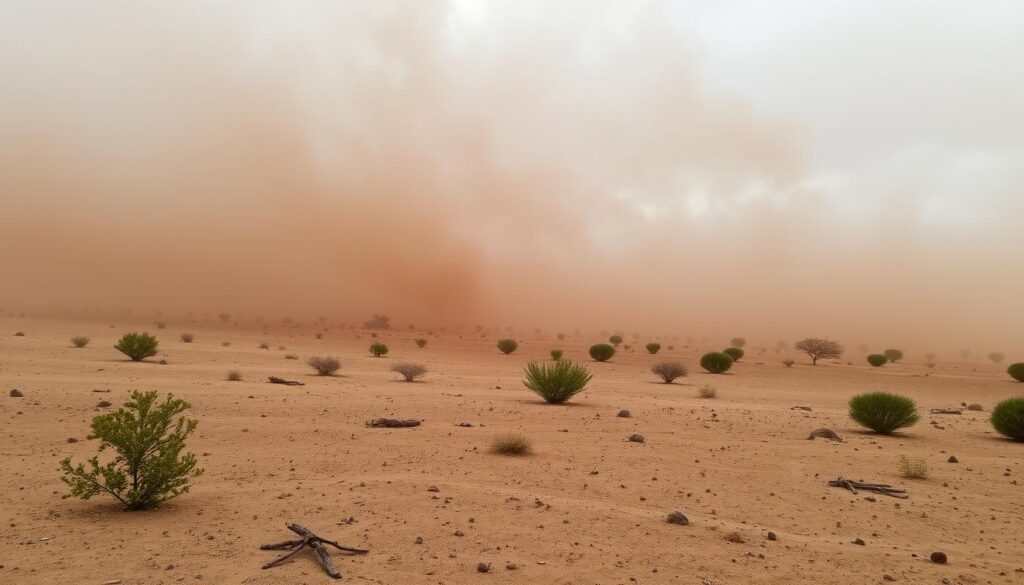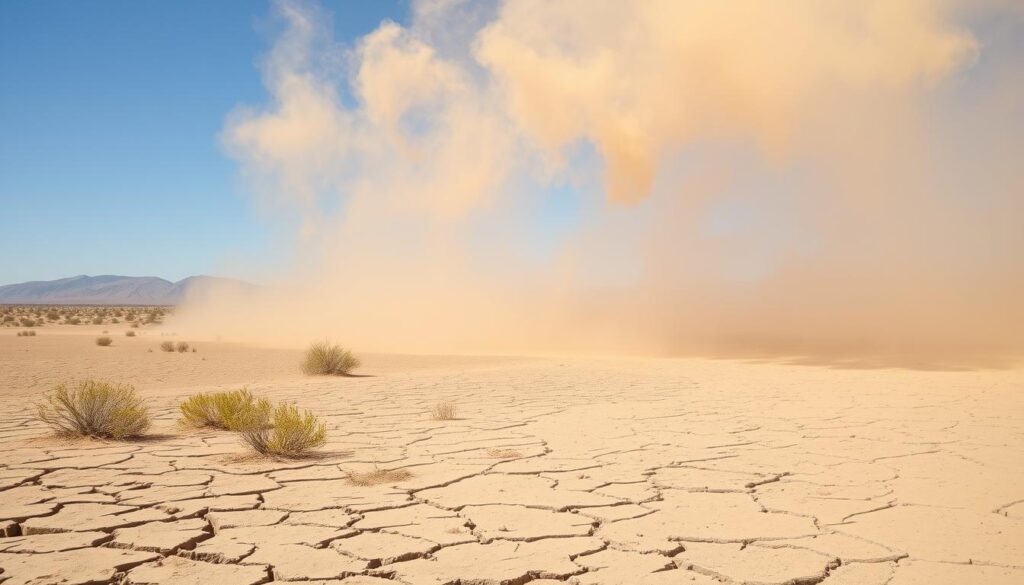
A vast arid landscape engulfed in a swirling dust storm, with muted colors blending in the turbulence, dark clouds of dust swirling violently against a barren horizon, sparse vegetation struggling to withstand the harsh winds, and distant mountains partially obscured by the thick, swirling particles of sand and dirt.
Dust storms are powerful weather events that happen in dry areas around the world, including parts of the United States. These storms lift and move huge amounts of dust and sand high into the air. They can cover large areas. It’s important to know how dust storms start, what they do, and how they affect dry regions.
Key Takeaways
- Dust storms occur when large quantities of dust and sand particles are lifted into the air, often over vast areas of arid or semi-arid regions.
- These storms can have significant impacts on the environment, including changes to the landscape, air quality, and agricultural productivity.
- Understanding the causes of dust storms, such as climate conditions and human activities, is essential for developing effective mitigation strategies.
- Dust storms can have far-reaching consequences, affecting not only local communities but also regional and global weather patterns.
- Researchers and policymakers are working to develop innovative solutions to address the challenges posed by dust storms and protect vulnerable populations.
What is a Dust Storm and Why Do They Occur?
A dust storm happens when a lot of dust and sand get lifted into the air by strong winds. These storms are common in dry areas where there’s little plant life to keep the soil down.
Defining a Dust Storm
A dust storm forms when the wind blows over dry, empty land. It picks up small soil, sand, and other particles, making them float in the air. Dry, barren lands are more likely to have dust storms because they have little moisture and few plants.
Arid Regions and Climate Conditions
Arid areas get very little rain, have high temperatures, and have few plants. This mix of conditions is perfect for dust storms. The dry soil is easy for the wind to move, and strong winds in these areas make storms worse.
| Climate Condition | Impact on Dust Storm Formation |
|---|---|
| Low Precipitation | Dry, loose soil that is easily eroded by wind |
| High Temperatures | Contributes to evaporation and lack of soil moisture |
| Sparse Vegetation | Lack of ground cover to hold soil in place |
| Strong Wind Patterns | Picks up and suspends fine soil and sand particles |
The right mix of dry climate, strong winds, and little vegetation makes dust storms more likely and intense in certain areas.
“Dust storms are a natural phenomenon that occur in arid and semi-arid regions, where the climate conditions make the soil susceptible to erosion and lofting by strong winds.”
Dust Storm Causes and Contributing Factors

A barren landscape with cracked earth and sparse vegetation, strong winds swirling dust particles into the air, a clear blue sky contrasting with the dusty haze, distant mountains barely visible through the dust, illustrating the arid conditions that contribute to dust storms.
Dust storms are a complex natural phenomenon influenced by various factors. These include environmental and human-driven elements. Understanding these causes is key to reducing their impact on arid regions.
Prolonged drought is a major natural cause of dust storms. When soil lacks moisture and vegetation, dry particles easily become airborne. This leads to dust clouds that can cover large areas. Changes in wind patterns also play a role in spreading these particles high into the atmosphere.
Human activities also play a big role in making dust storms worse. Overgrazing, poor land management, and unsustainable agricultural practices can harm soil stability. Climate change affects weather patterns, making dust storms more frequent and severe.
- Prolonged drought conditions
- Shifts in wind patterns and increased wind speeds
- Overgrazing and unsustainable land management
- Climate change and its effects on weather patterns
Understanding the mix of natural and human factors helps in creating solutions. Policymakers and communities can work together to tackle dust storm causes. This approach is crucial for managing this environmental challenge effectively.
“Dust storms are a complex interplay of natural and human-driven factors, requiring a multifaceted approach to address their impact on arid regions.”
Conclusion: Mitigating the Impact of Dust Storms
Dust storms can cause a lot of damage to communities, buildings, and nature. But, we can lessen their impact by understanding why they happen and taking action early. Practices like planting trees and protecting soil can cut down on dust.
It’s also key for communities to get ready for dust storms. This means having plans for emergencies, better warning systems, and teaching people how to stay safe. Working together in dry areas helps protect our homes and lives from dust storms.
To really tackle dust storms, we need to use science, support policies, and act together at the local level. By focusing on the main causes of dust storms, we can make our future safer and more stable in dry areas. Together, we can reduce the harm dust storms cause and prepare our communities for these tough weather events.
Important Point
| NO. | Important Points |
| 1. | About Us |
| 2. | Contact Us |
| 3. | Disclaimer |
| 4. | Privacy Policy |
FAQs of dust storms
What is a dust storm and why do they occur?
A dust storm happens when strong winds pick up a lot of dust and sand. This usually happens in dry, sandy areas where there’s little to hold the soil. Without much moisture or plants, the soil is easily blown away by winds.
What are the causes and contributing factors of dust storms?
Dust storms can start from many things, like long droughts or changes in wind. Human actions like overgrazing or bad farming also play a part. Climate change can make these storms worse by changing weather and how much rain falls.
What are the effects and impacts of dust storms on arid regions?
Dust storms can really hurt places in dry areas. They make it hard to see and breathe, damage crops, and mess up travel. They also make the soil erode, harming the land and plants over time.
How can the impact of dust storms be mitigated?
To lessen dust storm effects, people in dry areas need to know the causes and get ready. They should use good farming and land care, keep plants, and not overgraze. Being ready as a community and supporting research can also help protect the land and people.
What are the most effective strategies for managing dust storms?
Managing dust storms well needs both prevention and quick action. Preventing them means keeping plants, improving soil, and stopping erosion. Quick action includes early warnings, emergency plans, and working together to lessen damage. It’s important for everyone to work together to manage dust storms.
How can individuals and communities in arid regions prepare for and respond to dust storms?
People in dry areas can get ready for dust storms by knowing the weather and having plans. They should also protect buildings, stay inside during storms, and help each other. Working together helps communities stay safe and strong during dust storms.
